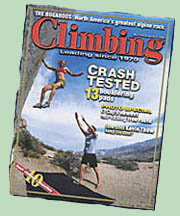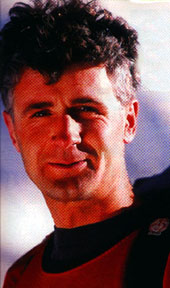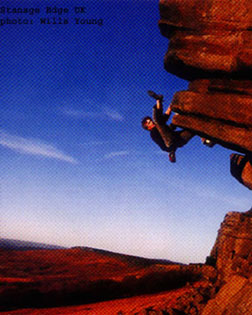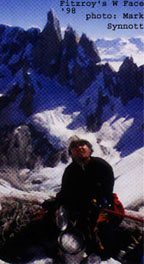|
Kevin Thaw
feature article from Climbing Magazine
Feature Article taken from
 Climbing Magazine #214, August 2002 Climbing Magazine #214, August 2002
The Frozen One
Whether it's a dicey V9, A5,
or alpine funk, Kevin Thaw keeps his cool. He just heats up when the subject
turns to acid techno and rave parties.
 W W e're standing in the middle of the Owens River Gorge Road, a three-mile stretch of
smooth asphalt running steeply down valley.
"If you start going too fast, and you get the wobbles, just lean your weight on
the front truck and start carving," says Kevin Thaw, demonstrating on his
three-foot-long skateboard. This road, located on the east side of the Sierra, California,
is only about 15 feet wide, so there's not a lot of room for such steering, especially at
high speed, or while cars come up from the opposite direction. "Singer [his friend
Jason "Singer" Smith] clocked me at 55 down Independence Pass," he says
matter-of-factly, "but I think this hill's faster, for sure."
I run ahead, hopefully contemplating a shorter, slower run of my own, and wait for
Kevin. The wind picks up, blowing hard downhill, the sort of wind that would send a
tumbleweed into a high-speed airborne cartwheel. Suddenly Thaw comes into view, rocketing
toward me amid a crescendo of humming urethane wheels. And he's gone, disappearing around
a steep turn, gaining momentum every second.
As he vanishes, I think: Wait a moment, he's not wearing a helmet, pads, wrist guards
— nothing to keep him from sliding into a long red streak across the black pavement.
This is like soloing a gritstone testpiece ... Worse: It's like soloing a gritstone
testpiece naked. This guy is a lunatic! Or ... or ... could it be that this stunt really
is as easy as he makes it seem?
I'm not even going to talk about how much it hurts when I crash. I feel as though I am
being catapulted toward oblivion. I hit the asphalt at maybe a touch over 20 miles per
hour, and basically eat it. Thaw reckons he tops his previous record, easily breaking 60.
"Sometimes," he counsels, "you just have to point it downhill and ride
it out."
Kevin Thaw, a tall, lean man with strong legs and a fit, muscular build, is a
cutting-edge alpinist with a knack for picking up any pastime that grabs his interest
— whether skateboarding, Thai boxing, boulder-jumping, aid, or mixed climbing —
and doing them all well. A Brit by birth, he seems the ideal caricature of a film-star
mountaineer. Clean-shaven, with dark hair that is fast-graying; he has a calm, refined,
yet forthright manner. When Pride and Prejudice meets Vertical Limit, Thaw
will be perfect in the lead role — a gentlemanly "Mr. Darcy" staring up at
K2 wearing a North Face jacket, crampons, and a chalk bag. "Doesn't look too
bad," he'll say, then bust out a V10 jump problem for a warm-up.
Thaw is a man with two distinct modes: He's either moving really fast, or he's barely
moving at all. Entering his "office" at his shared, rented house in Bishop,
California, he sits in slow mode. Every so often, he leans back in his chair to pull a
compact disc — all neatly catalogued, labeled with immaculate handwriting — from
a huge, mostly self-recorded library, and changes the music. To his right a computer
monitor — permanently on, and linked to the web — switches, when left alone, to
an image of Cerro Torre. A liquid-like "ball" bounces from edge to edge on the
screen, sending ripples across Patagonia's triple towers.
In this cozy environment, I have trouble correlating Thaw's climbing résumé with his
mellow persona. He has to be asked about his ascents or he does not talk directly about
them. Of Moon Madness, a top-end E7 (5.12+ R/X) on the gritstone of Curbar Edge,
England, he says, "One day I went back and I looked at it and saw holds, and how you
could put one hand here, pull up on that there... And it just made sense." He
talks with the same detachment about all his climbs, whether a "hard grit" E7
on-sight, M9 new routes in California and Colorado, a sub-four-hour blast up the Frendo
Spur in the Mont Blanc massif, or the second ascent of El Cap's notorious Reticent
Wall (A5). He has on-sighted M8 with the first pitch of Amphibian, in Vail,
Colorado. He has climbed The Eiger North Face — in both summer and winter.
In the Sierra, Thaw enchained Mount Whitney's East Buttress and East Face
routes via a descent of the Mountaineers Gully in just 2 hours 47 minutes. In the
Canadian Rockies, he soloed Mount Temple's mile-high Greenwood/Locke Route (V 5.9
A2) in an astonishing 4 hours 17 minutes.
Thaw has made 35 ascents of El Cap, including a six-hour blast up The Nose;
second and third ascents of the hardest A5 aid routes; many other cutting-edge aid lines,
each done in a push; an A4 first ascent; and a 20-hour solo record on the West
Buttress. In the late 1980s, when sport climbing was the ultimate in chic, Thaw even
redpointed top sport routes of the day, such as the hallowed Chouca (5.13c) at
Buoux, France. In his down time, he cranks V10/11 boulder problems. All in all, Thaw, 34,
must be considered one of the best all-around climbers in the world.
 The Frozen One!" says the renowned alpinist Conrad Anker, bringing up a
longstanding joke. "It's about time someone recognized him!" Better known than
any other aspect of Thaw's character is that he is coolly unfazed — by anything.
Once, when a burly, six-foot-plus bouldering Adonis, jealous of Thaw's prowess, was
boasting how he was going to rough Thaw up for encroaching on his turf, Thaw sought the
guy out, looked him in the eye, and said almost as an invite, "I heard you were going
to kick my ass." The situation was defused. The Frozen One!" says the renowned alpinist Conrad Anker, bringing up a
longstanding joke. "It's about time someone recognized him!" Better known than
any other aspect of Thaw's character is that he is coolly unfazed — by anything.
Once, when a burly, six-foot-plus bouldering Adonis, jealous of Thaw's prowess, was
boasting how he was going to rough Thaw up for encroaching on his turf, Thaw sought the
guy out, looked him in the eye, and said almost as an invite, "I heard you were going
to kick my ass." The situation was defused.
Mark Synnott, a world-traveling big-wall connoisseur, recalls how he and Thaw descended
Cerro Torre during a wild storm, and
their rap ropes became stuck, repeatedly. On one of Thaw's turns to sort things out, to
reach the point where the ropes were jammed, he led up, batmanning a decaying fixed line
that just happened to hang in the right place. The old line broke, sending Thaw for a
huge, unprotected (though roped) plummet down the granite ridge, past ledge after ledge of
rock. Catlike, Thaw jumped, palmed off, and dodged as he fell, and, in the middle of it
all, looked down at Synnott, made eye contact, and called, "Dude! Catch me ...."
with the cool of a crag-rat on a sport route.
Thaw's agility is near legendary. I have been out at Bishop's Happy Boulders with him,
where, rather than climbing up rocks like a regular boulderer, he turns the area into a
topsy-turvy gymnasium. He runs full-stride across the ground, makes a one-two step onto a
small boulder, and jumps for a bad sidepull high off the ground. He half catches it, and
vaults upward for a finishing jug. Down-climbing two moves, he crouches, then leaps
backward, turning 180 degrees in the air across a 10-foot void to land a two-handed rail,
legs swinging like crazy — no pads, and a miss would take his teeth out or land him
in the hospital with a broken neck. But Thaw doesn't miss. "The Two-Ring Circus"
he calls this trick.
Certainly, Thaw can combine his cool head with boundless energy, frequently powered by
a limitless supply of candy treats. But when he rests, even his voice slows to a barely
discernible crawl — impassive, like fingers scratching lazily over the bass string of
an electric guitar.
We'll be 'avin' it large at Havoc," Thaw tells me, when we hook up during a
December visit to England. He speaks with a deep, hypnotic voice and little cadence. He
uses brief sentences, sometimes cryptic, and alive with the patois of his social set.
It's OK, I'm clued into this: He and his friends will be dancing at the
"Havoc" night at a Manchester rave club.
Notwithstanding his easygoing politeness, Thaw is a freak for acid techno, and for five
or more hours of arm-waving, shaking, and gyrating amid a half-dressed college-age crowd,
and flashing strobes.
Excellent training — I guess.
Thaw's been doing a lot of this. Though now a resident of Bishop, California, he loves
to return to his former home in Uppermill, northern England, to enjoy the Manchester
clubbing scene. Mention music and he will launch into a rant about a night out, a mix he's
just finished, or some 70-minute "savage set" he recently purchased from the DJ
at the back of a dark, sweat-filled club.
But though he is up until 5 a.m. dancing, Thaw is also (I guess) preparing for a
February trip to Patagonia to attempt one of the most difficult alpine challenges in the
world — Cesare Maestri and Toni Egger's unrepeated, and possibly fictitious —
line up Cerro Torre's east and north faces. Mark Synnott calls the 5000-foot granite
route, with its ice-rimed, serac-guarded summit, "pretty much the craziest thing on
planet Earth."
A couple of days later, I join Thaw at Stanage Edge, in Britain's Peak District, a
five-mile-long escarpment of short but technical climbs. While he goes back to the car to
retrieve his climbing shoes, which he forgot, I walk ahead with the rest of our crew. Upon
arriving at the cliff, I am surprised to see Thaw has already caught up. By the time I've
laced up my own shoes, he has soloed up and down three or four short routes.
Thaw as a climber moves with an easy quickness, a kind of perpetual motion that
convinces mistaken onlookers that every hold he's pulling on is a jug. To him, these are
easy solos — 5.8s and 5.9s — but often the holds are sloping and subtle. It is
the way Thaw rolls the routes out, one after another without missing a beat, that
eventually makes you realize he is no average climber.
I ask Thaw about his trips up El Cap, and his adventures ice climbing in Scotland,
expecting a litany of dicey teetering with picks, and half-in cams 20 feet down. But the
last thing Thaw ever mentions is the climbing. Rather, it is: "Did I ever tell you
about our 10,000-foot season?" during which the late Dan Osman and Thaw racked up
10,000 vertical feet — in roped free-falls. Or it's an amused account of "how we
worked Miles," during a foray up what was later to become El Niño on El Cap, on
which Thaw, Jason Smith, and Osman conspired with bogus excuses to send Miles Smart up all
the long aid pitches, leaving nothing but the "fluffy" stuff for them: "We
had Miles going up there! ... 'Oh, dude, I'm kinda clipped under that ... You wanna lead
the next pitch?'"
Or it's "how we broke Alan," during a winter ice-climbing trip in Scotland,
the day he and Leo Houlding first met Alan Mullin. "Yeah, we did a new route
together. It was fun," says Thaw, giving away no emotion. Then, his voice abruptly
comes alive: "Actually, 'we broke Alan' was the most fun thing. ..." He
pauses while I grapple with this new riddle.
"A very serious Scottish guy ..." says Thaw. "And we ended up not
leaving the car till about noon [much later than Alan intended]. We stepped out of the car
and asked how long the walk in was. He said about an hour, hour and a half ... So we
jumped back in the car and went for a coffee as well."
Despite this veneer of disinterest and deadpan humor, Thaw is a consummate
professional. He is organized: even an ex-girlfriend says he kept his place annoyingly
tidy. His voluminous quantities of climbing equipment and technical clothing are stashed
neatly in shelves, drawers, and closets, stuffed item-within-item in containers around his
room.
Thaw's rare combination of skills has earned him a green card and the opportunity to
live and work in the United States. Combining a technical bent and knowledge from college
classes in mechanical engineering, he began gaining experience in aerial rigging for NBC
and Hollywood producers. His gift for design (he's put his mind into dozens of packs,
tents, ledges, haulbags, etc.) has meant he has become a major player in The North Face's
team of climbers, not only as one of their top athletes, but as a designer and tester.
"He's done so much around here," says Russ Mitrovich, an El Cap master and
big-wall aficionado who moved to California's East Side a year or so after Thaw.
"He's done every route I can think of. I don't understand how he did all that shit
because he just festers," Mitrovich says with a laugh. "He hangs out all the
time, and then in one week he'll go out and send all these things that would take me a
couple months to get done."
Mullin, the super-focused mixed master from Scotland, sees both sides to Thaw: "I
know he's really cool. But he can be very motivating. When the time's right, he's ready to
get on with it."
In Patagonia in 2000, Mullin accompanied Thaw on the so-called Czech (a.k.a., Slovak
) Route on the massive West Face of Fitzroy. As food and water ran out and the
weather turned ferocious, Thaw led every pitch free, up to 5.11c, from their one (planned) bivy to the top of Fitzroy's second tower, racing day and night in a 25-hour push,
covering 5000 feet of rock climbing. The pair descended from the Second Tower rather than
risk the quick rappel and short, rime-iced, rock traverse to the summit in the brutal
winds. turned ferocious, Thaw led every pitch free, up to 5.11c, from their one (planned) bivy to the top of Fitzroy's second tower, racing day and night in a 25-hour push,
covering 5000 feet of rock climbing. The pair descended from the Second Tower rather than
risk the quick rappel and short, rime-iced, rock traverse to the summit in the brutal
winds.
Astonishingly, the monster route was Mullin's first-ever alpine climb. Ask Thaw about
the route and it is not the difficulty of the climbing or the exhaustion he must have felt
that comes to his mind. "The winds there are proud," he says. "Clouds are
bulleting through the sky. You think, 'What is that over there?' And then it rockets
past."
In the beginning, Thaw was like any young lad in northern England who had just
discovered rock climbing. Uppermill, his hometown, was at the northeast edge of The Peak
District, with crags in view all around. "First, it was whatever was in the back
garden," says Thaw, who was 12 when he began climbing, "with a washing line
— one of those proper plastic-coated ones." Instead of tying in, he and friends
would climb with the line anchored to the top of the cliff: "If we got worried, we'd
grab it."
Later, at about the age of 14, he was caught reading a climbing magazine during a
geography lesson at high school. In that issue, he was credited with first ascents of a
couple of new routes. The class teacher took the magazine to the head of the geography
department, who happened to be a climber. Thaw expected a reprimand, but instead the two
of them talked for about 20 minutes about gritstone. "One [of the routes in that mag]
I'd graded E1 5b," says Thaw, who was super proud of the accomplishment. The grade
meant steady, traditional 5.9 or 5.10. (Today the route is in the latest guidebook as E4
6a — heady, traditional 5.11.) But Thaw's elders in the climbing community told him
he should get out to the big cliffs, where there was real climbing to be done. Thaw
already agreed: "I was at that age where I was checking out [the cartoon books] Asterix
the Gaul and [Joe Tasker's alpine-climbing classic] Savage Arena at the same
time," he says.
"It was funny," says Thaw with a smile.
"It was the guys [I was climbing with] who were getting tugged up Hard VS's
[traditional 5.8s] that were the ones pushing me to do bigger things."
"You were thinking: 'Wow, this old guy can't even get hauled up this Hard VS, but
he just goes off in the mountains, I guess.'"
There is another of those long silences while I decipher the riddle.
"They burn you with Dogma," he adds. Then, adopting the supercilious tone of
the naysayer, Thaw tilts his head back and eyes me askance: "You'll be able to do that
... But this, this, and this will be impossible."
To Thaw, "Dogma" involves the eulogizing of the elite, the super-sizing of
heroes and their heroism, with an accompanying dismissal of all else. "Dogma,"
says Thaw, "is how climbing's dished out to you."
Thaw read all the mags. He read the books. He lived in awe of every aspect of climbing.
A favorite route, or a favorite style of climbing, as he will say now, is simply,
"The one I was doing last." The very day after his engineering finals in
England, Thaw was on a plane to America, and was soon touring the continent from climbing
area to climbing area.
"In America I was free of Dogma," says Thaw, "climbing the rap-bolted
routes that the trad climbers belittled and then leading the trad routes that they held so
sacred — swinging both ways."
Says his friend Steve Edwards, "In Yosemite, he got psyched on aid climbing and
all of a sudden he kept doing harder and harder routes. For a while there he would just go
up on anything anyone said was hard."
 Over four years from 1994 to 1997 Thaw completed Sea of Dreams (VI 5.10 A5) with
Warren Hollinger, KAOS (VI 5.7 A4) with Eric Erikson and Bill Leventhall, Wyoming
Sheep Ranch (VI 5.10 A5) with Dale Bard, Roulette (V A5 on The Leaning Tower)
with Odroar Wiik, and Space (VI 5.10 A4 — solo). He made the third ascent of Gulf
Stream (VI 5.10 A4+) with Tim Wagner, the second of Plastic Surgery Disaster
(VI 5.10 A5) with Chris Kalous, and the first ascent of the unrepeated Continental
Drift (VI 5.10 A4) with Steve Gerberding and Conrad Anker. Over four years from 1994 to 1997 Thaw completed Sea of Dreams (VI 5.10 A5) with
Warren Hollinger, KAOS (VI 5.7 A4) with Eric Erikson and Bill Leventhall, Wyoming
Sheep Ranch (VI 5.10 A5) with Dale Bard, Roulette (V A5 on The Leaning Tower)
with Odroar Wiik, and Space (VI 5.10 A4 — solo). He made the third ascent of Gulf
Stream (VI 5.10 A4+) with Tim Wagner, the second of Plastic Surgery Disaster
(VI 5.10 A5) with Chris Kalous, and the first ascent of the unrepeated Continental
Drift (VI 5.10 A4) with Steve Gerberding and Conrad Anker.
Mark Synnott, who was putting in his Valley dues around the same time, feels that one
line stood out above the others at the time: "The Reticent was kind of the big
prize."
In 1997, The Reticent Wall (VI 5.9 A5) had been climbed only by Steve Gerberding
— The Valley's undisputed aid master — who described the crux section as the
hardest on El Cap. "At the time nobody wanted to step up because it had a pretty mean
reputation with this A5 crux above a bad fall," explains Synnott. "Kevin wanted
to do it, but Chris Kalous and I were both worried that something would happen to him on
the way up and then we'd have to lead it."
The pitch, now known as The Natural, was the only pitch Gerberding had ever rated A5.
"It was a genuine A5 when we did it," says Thaw. "Aid climbing is the
ultimate gray area in climbing. But your second keeps you honest." He pulled off 175
feet of cautious climbing up bodyweight beak and hook placements without a single one
enhanced. "That is one of the only times I have watched someone truly risk his
life," says Synnott.
Asked whether this is truly climbing, or merely engineering, Thaw has a straight
answer: "I'm saying it's totally fun."
"Yosemite opens eyes," adds Thaw during another conversation. "Or it
opens mine. It is also the ultimate training ground."
Certainly, the difficulty of the glaciated approaches and the sheer size of the towers
make Patagonia a big step up from Yosemite, yet, given good conditions, climbers can grab
a rope, a rack, and an overnight bag, and crank big routes (5000 to 7000 feet long) in
astonishing times.
"I think the blending of styles is the key to getting to the next level,"
says Thaw. He means not merely the blending of climbing skills, but the blending of
alpine-style (no fixed ropes), free-as-possible, and speed-style, three different
approaches that are perfected in different arenas.
He is not personally much interested in climbing an alpine route "in-a-push"
as a goal, rather than as a result of the need for speed. On El Cap, or another
such "training ground," in-a-push ascents are a means of gaining experience.
But, in the mountains, Thaw points out, the length of real climbing time spent completing
an in-a-push alpine ascent may be no less than that taken on previous alpine-style ascents
that included a bivy. He is more interested in other aspects — such as whether a bolt
kit was taken, bolts were placed, fixed ropes were used, and the route was climbed free.
Thaw enlists Mullin and Houlding for the Maestri-Egger route on Cerro Torre.
Mullin is a self-taught, highly ambitious Scottish mixed climber who knocked the crust off
prior standards the day he first donned crampons. Houlding's nervy rock exploits and sheer
gymnastic brilliance are held in awe throughout the world.
The team doesn't take drilling gear or extra ropes to fix. The climbers go light, with
only the most basic bivy gear, intended for a short break at the col between Torre Egger
and Cerro Torre. However, when they begin the route, the three find a mess of old fixed
equipment, including static lines. Houlding gets suckered by one fixed line into a
difficult and exhausting free-climbing sequence. At the end of the pitch, he slips as he
tries a hard, virtually hands-free rock-over. Falling 30 feet in a twisting roll, Houlding
swings into a corner. His ankle breaks.
The accident occurs just four hours into the climb. The three are already about 700
feet up the face. Thaw and Mullin scramble to help Houlding down — with the fixed
line, ironically, speeding their descent. Reaching the glacier, Thaw picks the 170-pound
Houlding up, piggyback, and starts the march down.
"He carried me for a good two hours," says Houlding. "He was walking
quicker than the others, with me on his back!"
Thaw will return. "The route's totally doable; totally sendable," he says.
"I can see us doing a lot more climbing together in the future," says
Houlding. "We were a good team, definitely. Very chilled ... And very fast."
Wills Young is a freelance writer living in Bishop, California.
http://www.climbing.com
All
contents of this site © 2000-2002 Climbing Magazine
<< Back to Index Page
<Articles/Trips Page
|